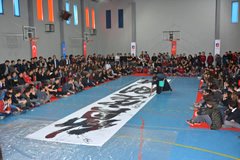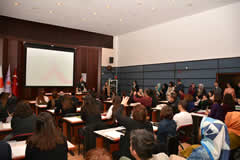Achievements of the Japanese-Language Network in Turkey
The Turkish-Japanese Foundation Culture Center
TATSUKI Chika
Twice Yearly Japanese-Language Proficiency Test (JLPT)
Although there are many foreign language proficiency tests conducted in Turkey, the only officially authorized Japanese-language test is for the civil service examination. To receive authorization, a test must be held at least twice a year and have been conducted continuously for multiple years. In Turkey the Japanese-Language Proficiency Test (hereinafter “JLPT”) is held each year in December, but to date it has not received official approval.
Online applications for JLPT were launched in Turkey from 2014. Initially, applications required an application form to also be completed, but from 2015 applications were received online only and the number of applicants increased rapidly. So much so that the locations we used each year for the test started to feel overcrowded.
We therefore decided to hold the JLPT twice a year in Turkey, for the two reasons of gaining official approval for JLPT and splitting test-takers into two groups. Although the test is still only held in Ankara, most of the people taking the test are from Istanbul. The next task will be to hold the JLPT in multiple locations around Turkey.
New Japanese-Language Education

Calligraphy performance at Atayurt Secondary School
Last October, the Japanese-language education community in Turkey received some hot news that Japanese-language tuition would begin in two new secondary schools. Japanese-language started as a compulsory club for secondary school students at Atayurt Secondary School in Eskişehir. At Yaşam Tasarım Secondary School in the city of Alanya on the shores of the Mediterranean Sea, Japanese language was introduced as an official class. I helped in my own small way in launching Japanese-language education at these two schools.
I conducted a demonstration lesson at Atayurt Secondary School last October for the teachers there. I hear that not a single one of the 23 students who attended that class has given up, and all have continued their Japanese-language studies during the semester. I would like to praise the teachers for their hard work.
Yaşam Tasarım Secondary School contacted me after experiencing difficulty in finding a Japanese-language teacher, so I visited the school and held a special class. It was the first time for many of the students to meet a Japanese person and they were all very excited. I ended the class by introducing a Japanese song. However, after that class, the students all kept asking for Japanese, so the school principal kept looking for a Japanese-language teacher, and finally Japanese-language tuition started in mid-October last year.
Japanese Cultural Experience Events
Even in regions where there is not a single Japanese person, there is still deepening interest in Japan and Japanese language. There are still only three universities in Turkey that have established a Japanese-language degree program. Another university is expected to start accepting students on a Japanese course from September. Looking at the numbers of people taking JLPT, you can see that there is growing demand for Japanese-language tuition. In order to support the Japanese-language education community in Turkey, over the course of 10 days I travelled to six organizations in five cities for a calligraphy performance and workshop event.

Calligraphy workshop at TJV
last June, the calligraphy artist SUZUKI Mohri visited Ankara from Japan, and held a calligraphy event at the Turkish-Japanese Foundation Culture Center (hereinafter “TJV”). Some participants at the workshop had travelled for 10 hours by bus to get there. There were so many people hoping to participate that unfortunately not every could attend. So in March this year, we asked Mr. Suzuki to come to Turkey again. The theme for the event this time was to target areas far away from the major cities, and through calligraphy to interact with people who are learning Japanese, or who are involved with Japan in some way. Events began almost as soon as Mr. Suzuki had landed in Turkey, and although the itinerary was very challenging, including some very long bus journeys, everywhere he went Mr. Suzuki got plenty of energy from delicious Turkish food and never stopped smiling throughout the various exchange events. While many people were holding a calligraphy brush in their hand for the first time, there were some who enjoy creating calligraphy in their own unique style, and others who were hearing Japanese and meeting Japanese people for the first time. All of these people were astonished by Mr. Suzuki’s dynamic performance and also a little apprehensive, as they took up brushes themselves and ran them over the calligraphy paper provided. After the event there were even some schools that issued Japanese-language learning orders to their teachers. The calligraphy exchange between Japan and Turkey was a great success around the country.
TJV is trying many things to tap into the potential demand for Japanese-language education in Turkey. With the limited human resources available, we are boldly engaging in various efforts, both large and small in scale, including reform of general Japanese language courses and Japanese speech contests, the twice-yearly implementation of JLPT, and holding of various Japan-related events. Of course, these things wouldn’t be possible with TJV working alone, and they are all thanks to the cooperation of people linked by the keyword “Japanese language.” TJV will continue to support Japanese-language education in Turkey through our Japanese-language network that stretches beyond Ankara to the rest of Turkey, and also to the rest of the world.
- What We Do Top
- Arts and Cultural Exchange [Culture]
- Japanese-Language Education Overseas [Language]
- Japanese-Language Education Overseas [Language] Top
- Learn Japanese-language
- Teach Japanese-language
- Take Japanese-Language Test
- Know about Japanese-language education abroad
- The Japanese-Language Institute, Urawa
- The Japanese-Language Institute, Kansai
- Japanese-Language Programs for Foreign Specified Skilled Worker Candidates
- Japanese Language Education for Japanese Children Resident Overseas and for the Descendants of Migrants
- Archives
- Japanese Studies and Global Partnerships [Dialogue]
- JF digital collection
- Other Programs / Programs to Commemorate Exchange Year
- Awards and Prizes
- Publications
